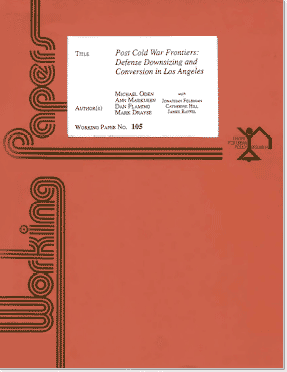 This study examines how firms, workers, and regional economic development institution are dealing with the severe effects of defense downsizing in the Los Angeles region. Between 1988 and 1994 the Los Angeles region lost 127,000 jobs in defense-related industries, including aircraft, missiles, instruments, and electronics. The long economic slump set off by defense cuts has incited a major debate between the advocates of regional institution building and proactive economic development and those arguing for the laissez-faire approach of reducing taxes, wages, and environmental costs.
This study examines how firms, workers, and regional economic development institution are dealing with the severe effects of defense downsizing in the Los Angeles region. Between 1988 and 1994 the Los Angeles region lost 127,000 jobs in defense-related industries, including aircraft, missiles, instruments, and electronics. The long economic slump set off by defense cuts has incited a major debate between the advocates of regional institution building and proactive economic development and those arguing for the laissez-faire approach of reducing taxes, wages, and environmental costs.
The Los Angeles economy was considerably weaker in the previous two decades than aggregate data revealed. The boom of the 1980s was largely based on deficit-financed military spending that could not last. When it came to an end, the destruction of manufacturing jobs was as bad if not worse than that in steel and machining in the rustbelt in the 1980s. Although Los Angeles has other strong sectors — media and entertainment, apparel, and port-related trade, its business service sector was not as well-developed as that of other large cities of its size. Even today, a degree of denial (reminiscent of the midwest in the early 1980s) prevents the region from mobilizing as rapidly as it might in response. Although there is considerable interest in the media market, and Hollywood-related employment has indeed been booming, it would be a mistake to assume that such single-sector growth can be sustained or that it can substitute for additional losses in high technology manufacturing.
Addressing the potential for the Los Angeles aerospace complex requires understanding why it has been so vulnerable to cutbacks. This is the complex product of (1) the concentration of large and previously quite insulated companies currently under tremendous pressure from Wall Street; (2) the high-cost economy of the region, itself an historical product of the aerospace complex and its special status as a government supplier; (3) a growing weakness in the agglomerative glue in the region, with large Cold War contractors lacking much informal connection to each other, consolidating with units located elsewhere and purchasing components from all over the country; (4) political pressures reinforcing the lure of other gunbelt locations; (5) the sheer size and rapidity of defense cuts and their concentration in Cold War weapons systems which were Los Angeles’ comparative advantage; and (6) the absence of alternative use planning and confidence on the part of area contractors in a commercial future.
What would a Los Angeles-friendly platform look like? It would first of all demand that defense budget cuts be partially funneled into three to five year one-time-only conversion assistance programs. Where longer term worker retraining and company technical assistance have been made available, they work. Second, the TRP should be re-oriented once again toward proposals that translate military technologies into civilian products. Third, the infrastructure investments envisioned three years ago as part of a national economic development strategy should be undertaken. Investments of this sort increase long-term productivity in the economy and provide, just as the Cold War did, a new market for technologically innovative products. Fourth, environmental regulations which have been driving innovation in the automobile market should be retained and protected from erosion by deregulatory forces. Not only do they work toward cleaner air and better health for Los Angeles residents, they transform the region into a living laboratory for experimentation with new forms of transportation which could help jump start internationally competitive industries for the future. Fifth, the region should oppose the lax and lopsided Pentagon policy favoring defense industrial base consolidation. Subsidies that encourage facility shutdown and relocation should be opposed, and mega-mergers okayed only after careful study of the longer range consequences for national security and the taxpayer’s pocket book.
Finally, some jawboning of large Los Angeles military contractors would be in order, via shareholder and federal government channels as well as locally. It is in the companies’ collective interest to preserve a sophisticated regional technology base as it is also in the interest of Los Angeles residents and small businesses. It is the nation’s interest not to have to bear the costs of an infrastructure abandoned and a large population reliant on social services to take up the slack. The region deserves a return on its decades-long investment in the industry, both from the federal government and from its major corporate members.
Los Angeles remains America’s premier aerospace, communications, and electronics complex. However, defense demand will no longer support the region’s high technology industries. the new growth sectors — including entertainment, apparel, and business services — will not be able to replace the high quality jobs lost through downsizing. Achieving balanced and dynamic growth in the post Cold War environment will require reorienting the talent and technology in aerospace-related manufacturing and patiently building new growth industries to replace defense losses. This will not be achieved by simply lowering wages and regulatory costs. Creation of family-supporting jobs will require long-term proactive and cooperative efforts by the region’s political, labor, and business leaders.
© Center for Urban Policy Research, Rutgers, The State University of New Jersey, 1996. This report is posted on-line due to being elsewhere unavailable for viewing or purchase.












